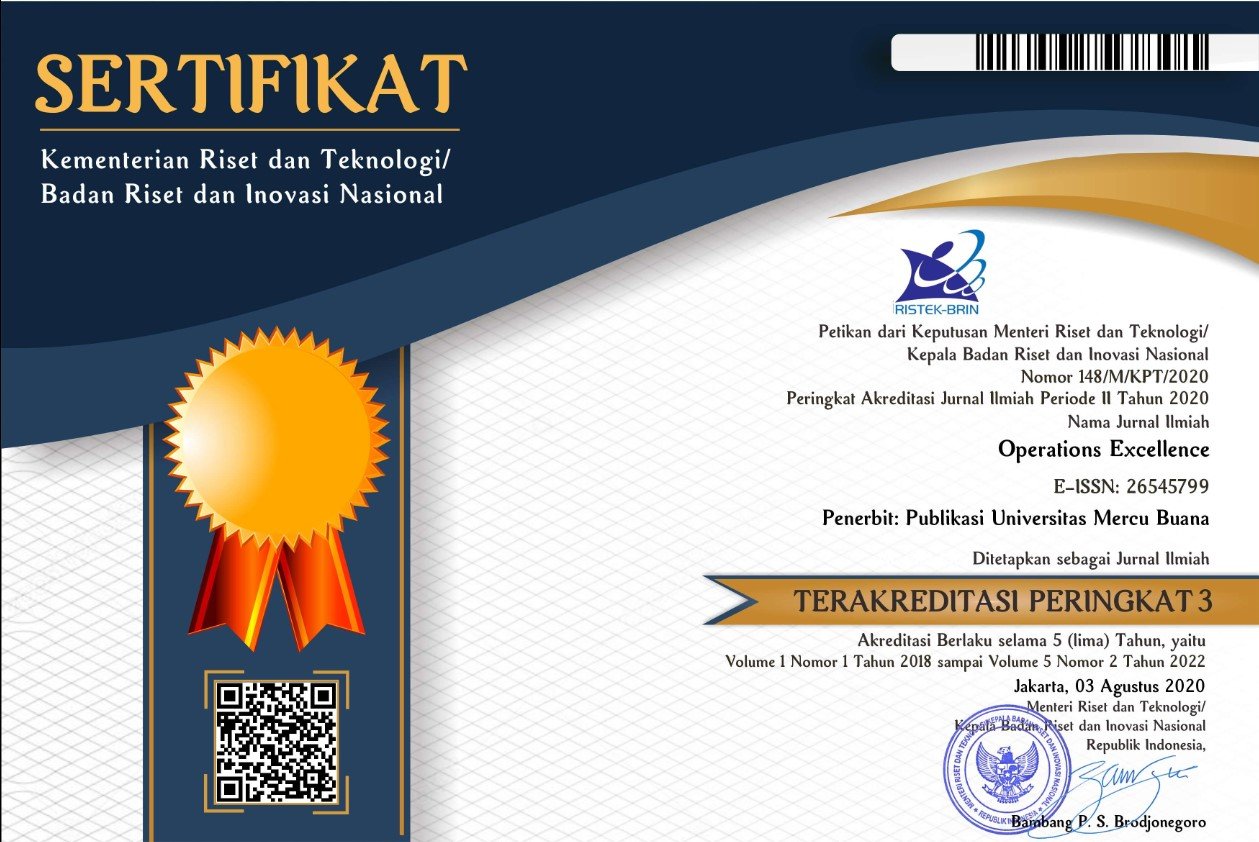Assessing critical indicators of supply chain ambidexterity in the 3PL industry: Insights from Indonesia
Abstract
Supply chain ambidexterity (SCX) is essential strategy for enhancing the competitiveness and business continuity of third-party logistics (3PL) companies in Indonesia. SCX combines the approaches of Supply Chain (SC) agility and SC integration simultaneously to foster business performance. However, research on the factors influencing SCX remains limited. This study integrated the Fuzzy Delphi Method (FDM) to validate 41 proposed indicators and applied Best-Worst Method (BWM) to assess the relative weight and examine the most and least effective indicators for Indonesia’s 3PL industry. The findings revealed 17 effective indicators, with the top 5 being SC sensing, adaptability, process optimization, regulatory compliance, and employee competency development, which were identified as the most significant indicators. These indicators are critical drivers that ensure the successful implementation of SCX strategy. The results offer valuable insights to professionals and policymakers, helping them formulate strategies to strengthen ambidextrous capabilities in the dynamic environment of the 3PL sector, thereby contributing to a more sustainable and competitive logistics landscape in Indonesia.
Keywords
Full Text:
PDFReferences
Agarwal, N., & Seth, N. (2021). Analysis of supply chain resilience barriers in Indian automotive company using total interpretive structural modelling. Journal of Advances in Management Research, 18(5), 758-781. https://doi.org/10.1108/JAMR-08-2020-0190
Ahmed, F., Hu, W., Arslan, A., & Huang, H. (2024). Ambidexterity of HR practices in fortune 500 companies and employee innovation performance: mediating role of inclusive leadership. Journal of Organizational Change Management, 37(2), 237-254. https://doi.org/https://doi.org/10.1108/JOCM-05-2022-0139
Alamsjah, F., & Yunus, E. N. (2022). Achieving Supply Chain 4.0 and the Importance of Agility, Ambidexterity, and Organizational Culture: A Case of Indonesia. Journal of Open Innovation: Technology, Market, and Complexity, 8(2), 83. https://doi.org/https://doi.org/10.3390/joitmc8020083
Aldianto, L. (2021). Toward a business resilience framework for startups. https://api.elsevier.com/content/abstract/scopus_id/85103096704
Alsmairat, M. A. K., & Al-Shboul, M. d. A. (2023). Enabling supply chain efficacy through supply chain absorptive capacity and ambidexterity: empirical study from Middle East region - a moderated-mediation model. Journal of Manufacturing Technology Management, 34(6), 917-936. https://doi.org/10.1108/JMTM-10-2022-0373
Ambulkar, S., Ralston, P. M., Polyviou, M., & Sanders, N. (2023). Frequent supply chain disruptions and firm performance: the moderating role of exploitation, exploration and supply chain ambidexterity. International Journal of Physical Distribution & Logistics Management, 53(10), 1261-1285. https://doi.org/10.1108/IJPDLM-01-2023-0051
Anggadwita, G. (2021). The Implementation of Technology Capabilities, Agile Leadership and Innovation Ambidexterity to Improve SMEs’ Sustainability in Bandung.
Ashrafi, A., & Zareravasan, A. (2022). An ambidextrous approach on the business analytics-competitive advantage relationship: Exploring the moderating role of business analytics strategy. Technological Forecasting and Social Change, 179, 121665. https://doi.org/https://doi.org/10.1016/j.techfore.2022.121665
Aslam, B., Abbas, S., Ahmad, Y., Shah, S. T. H., & Raza, M. (2024). Interplay of emerging industrial technologies, ambidexterity, and sustainability: The case of the textile sector. Sustainable Production and Consumption, 49, 372-386. https://doi.org/https://doi.org/10.1016/j.spc.2024.07.006
Aslam, H., Khan, A. Q., Rashid, K., & Rehman, S.-u. (2020). Achieving supply chain resilience: the role of supply chain ambidexterity and supply chain agility. Journal of Manufacturing Technology Management, 31(6), 1185-1204. https://doi.org/10.1108/JMTM-07-2019-0263
Benzidia, S., Makaoui, N., & Subramanian, N. (2021). Impact of ambidexterity of blockchain technology and social factors on new product development: A supply chain and Industry 4.0 perspective. Technological Forecasting and Social Change, 169, 120819. https://doi.org/https://doi.org/10.1016/j.techfore.2021.120819
Bui, T.-D., Tsai, F. M., Tseng, M.-L., Tan, R. R., Yu, K. D. S., & Lim, M. K. (2021). Sustainable supply chain management towards disruption and organizational ambidexterity: A data driven analysis. Sustainable Production and Consumption, 26, 373-410. https://doi.org/https://doi.org/10.1016/j.spc.2020.09.017
Feizabadi, J., Gligor, D. M., Alibakhshi Motlagh, S., & Srivastava, R. (2024). When and under what conditions ambidextrous supply chains prove effective? Insights from simulation and empirical studies. Transportation Research Part E: Logistics and Transportation Review, 183, 103461. https://doi.org/https://doi.org/10.1016/j.tre.2024.103461
Figueiredo, M., Ferreira, J. J., & Vrontis, D. (2024). Perspectives on dynamic capabilities and ambidexterity in born-global companies: Theoretical framing, review and research agenda. Journal of International Management, 30(1), 101099. https://doi.org/https://doi.org/10.1016/j.intman.2023.101099
Gala-Velásquez, B. D. l., Ruiz-Ortega, M. J., García-Villaverde, P. M., & Hurtado-Palomino, A. (2024). Can ambidexterity lead to pioneering orientation in adverse situations? A new approach about when and how. Technological Forecasting and Social Change, 198, 122993. https://doi.org/https://doi.org/10.1016/j.techfore.2023.122993
Gastaldi, L., Lessanibahri, S., Tedaldi, G., & Miragliotta, G. (2022). Companies’ adoption of Smart Technologies to achieve structural ambidexterity: an analysis with SEM. Technological Forecasting and Social Change, 174, 121187. https://doi.org/https://doi.org/10.1016/j.techfore.2021.121187
Gu, M., Yang, L., & Huo, B. (2021). The impact of information technology usage on supply chain resilience and performance: An ambidexterous view. International Journal of Production Economics, 232, 107956. https://doi.org/https://doi.org/10.1016/j.ijpe.2020.107956
Herburger, M., Wieland, A., & Hochstrasser, C. (2024). Building supply chain resilience to cyber risks: a dynamic capabilities perspective. Supply Chain Management: An International Journal, 29(7), 28-50. https://doi.org/10.1108/SCM-01-2023-0016
Iborra, M., Safón, V., & Dolz, C. (2020). What explains the resilience of SMEs? Ambidexterity capability and strategic consistency. Long Range Planning, 53(6), 101947. https://doi.org/https://doi.org/10.1016/j.lrp.2019.101947
Iftikhar, A., Ali, I., & Stevenson, M. (2024). The silver lining of supply chain complexity: building supply chain resilience and robustness through exploitation and exploration. Supply Chain Management: An International Journal, 29(2), 244-259. https://doi.org/10.1108/SCM-01-2023-0022
Khan, S. A. R., Piprani, A. Z., & Yu, Z. (2023). Supply chain analytics and post-pandemic performance: mediating role of triple-A supply chain strategies. International Journal of Emerging Markets, 18(6), 1330-1354. https://doi.org/10.1108/IJOEM-11-2021-1744
Kraus, P., Stokes, P., Tarba, S. Y., Rodgers, P., Dekel-Dachs, O., Britzelmaier, B., & Moore, N. (2022). The ambidextrous interaction of RBV-KBV and regional social capital and their impact on SME management. Journal of Business Research, 142, 762-774. https://doi.org/https://doi.org/10.1016/j.jbusres.2021.12.047
Leitão, J., de Brito, S., & Pereira, D. (2024). Organizational ambidexterity, open innovation and innovation outputs: How do followers and low-flyer EU countries innovate? International Journal of Innovation Studies, 8(2), 186-235. https://doi.org/https://doi.org/10.1016/j.ijis.2024.01.001
Matas, J., Perez, N., Ruiz, L., & Riquelme-Medina, M. (2024). Firm disruption orientation and supply chain resilience: understanding mechanisms to mitigate disruption impact. Journal of Business & Industrial Marketing, 39(13), 82-95. https://doi.org/10.1108/JBIM-10-2023-0562
Munir, M., Jajja, M. S. S., & Chatha, K. A. (2022). Capabilities for enhancing supply chain resilience and responsiveness in the COVID-19 pandemic: exploring the role of improvisation, anticipation, and data analytics capabilities. International Journal of Operations & Production Management, 42(10), 1576-1604. https://doi.org/10.1108/IJOPM-11-2021-0677
Nakandala, D., Elias, A., & Hurriyet, H. (2024). The role of lean, agility and learning ambidexterity in Industry 4.0 implementations. Technological Forecasting and Social Change, 206, 123533. https://doi.org/https://doi.org/10.1016/j.techfore.2024.123533
Ojha, D., Acharya, C., & Cooper, D. (2018). Transformational leadership and supply chain ambidexterity: Mediating role of supply chain organizational learning and moderating role of uncertainty. International Journal of Production Economics, 197, 215-231. https://doi.org/https://doi.org/10.1016/j.ijpe.2018.01.001
Partanen, J., Kohtamäki, M., Patel, P. C., & Parida, V. (2020). Supply chain ambidexterity and manufacturing SME performance: The moderating roles of network capability and strategic information flow. International Journal of Production Economics, 221, 107470. https://doi.org/https://doi.org/10.1016/j.ijpe.2019.08.005
Priyanka, Jain, M., & Dhir, S. (2022). Antecedents of organization ambidexterity: A comparative study of public and private sector organizations. Technology in Society, 70, 102046. https://doi.org/https://doi.org/10.1016/j.techsoc.2022.102046
Saleh, R. H. (2023). What makes innovation ambidexterity manageable: a systematic review, multi-level model and future challenges. Review of Managerial Science, 17(8), 3013-3056. https://doi.org/10.1007/s11846-023-00659-4
Sarkis, J. (2024). The Palgrave Handbook of Supply Chain Management. Springer.
Shamout, M. D. (2023). Analyzing the moderating role of coopetition network size on the impact of analytics capabilities, ambidexterity, and coopetition on firm performance. Journal of Co-operative Organization and Management, 11(1), 100203. https://doi.org/https://doi.org/10.1016/j.jcom.2023.100203
Srisathan, W. A., Ketkaew, C., & Naruetharadhol, P. (2023). Assessing the effectiveness of open innovation implementation strategies in the promotion of ambidextrous innovation in Thai small and medium-sized enterprises. Journal of Innovation & Knowledge, 8(4), 100418. https://doi.org/https://doi.org/10.1016/j.jik.2023.100418
Stekelorum, R., Laguir, I., Lai, K.-h., Gupta, S., & Kumar, A. (2021). Responsible governance mechanisms and the role of suppliers’ ambidexterity and big data predictive analytics capabilities in circular economy practices improvements. Transportation Research Part E: Logistics and Transportation Review, 155, 102510. https://doi.org/https://doi.org/10.1016/j.tre.2021.102510
Tsai, F. M., Bui, T.-D., Tseng, M.-L., Lim, M. K., & Hu, J. (2020). Municipal solid waste management in a circular economy: A data-driven bibliometric analysis. Journal of Cleaner Production, 275, 124132. https://doi.org/https://doi.org/10.1016/j.jclepro.2020.124132
Tseng, M.-L., Bui, T.-D., Lim, M. K., Fujii, M., & Mishra, U. (2022). Assessing data-driven sustainable supply chain management indicators for the textile industry under industrial disruption and ambidexterity. International Journal of Production Economics, 245, 108401. https://doi.org/https://doi.org/10.1016/j.ijpe.2021.108401
Vega, D., Arvidsson, A., & Saïah, F. (2023). Resilient supply management systems in times of crisis. International Journal of Operations & Production Management, 43(1), 70-98. https://doi.org/10.1108/IJOPM-03-2022-0192
Wamba, S. F., Dubey, R., Gunasekaran, A., & Akter, S. (2020). The performance effects of big data analytics and supply chain ambidexterity: The moderating effect of environmental dynamism. International Journal of Production Economics, 222, 107498. https://doi.org/https://doi.org/10.1016/j.ijpe.2019.09.019
Yalcin, M. G., & Ashraf, M. H. (2024). Viewing Supply Chain Ambidexterity (SCX) Through Paradox Theory and an Innovation Framework. In The Palgrave Handbook of Supply Chain Management (pp. 271-292). Springer. https://doi.org/https://doi.org/10.1007/978-3-030-89822-9_104-1
DOI: http://dx.doi.org/10.22441/oe.2025.v17.i2.139
Refbacks
- There are currently no refbacks.
Copyright (c) 2025 Operations Excellence: Journal of Applied Industrial Engineering

This work is licensed under a Creative Commons Attribution-ShareAlike 4.0 International License.
Journal ISSN:
| Print ISSN: 2085-4293 | |
| Online ISSN: 2654-5799 |
Tim Editorial Office
Operations Excellence: Journal of Applied Industrial Engineering
Magister Teknik Industri Universitas Mercu Buana
Jl. Raya Meruya Selatan No. 1 Kembangan Jakarta Barat
Email: [[email protected]]
Website: http://publikasi.mercubuana.ac.id/index.php/oe
Journal DOI: 10.22441/oe
The Journal is Indexed and Journal List Title by:

.png)
.png)
.png)


Operations Excellence: Journal of Applied Industrial Engineering is licensed under a Creative Commons Attribution-NonCommercial-ShareAlike 4.0 International License.










